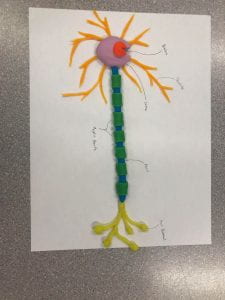Neuron Communication
What are Neurons?
Neurons are classified as nerve cells that receive and send electrical signals over long distances within the human body. A neuron receives electrical signals from the sensory neurons and other neurons. The neurons send electrical signals to motor neurons and to other neurons. The neuron that sends signals between the neurons is classified as the inter-neuron.
Sensory Neuron
Inter Neuron
Motor Neuron
Neuron Structure:
Dendrite: receives stimulation from other neurons and sensory receptors, and conducts electrical messages to the neuron’s soma in order for the cell to properly function.
Nucleus: provides main energy needed in order for the nerve cell to function properly.
Soma (Cell Body): contains the nucleus and connects with the dendrites; it’s function is to form information received by the neuron’s dendrites.
Axon: a long cylindrical structure that carries and transmits the neuron’s information to different neurons, muscles, and glands.
Myelin Sheath: insulating layer (lipid substance) that surrounds the nerve cell’s axon; the myelin sheath increases the speed of electrical impulses that travel along the nerve cells.
Terminal Buttons: located at the end of the neuron; it’s main function is to send information to other neurons through the synapse.
Neuron Function:
An electrochemical signal that occurs within a neuron is classified as Action Potential (nerve impulse). The direction of the nerve impulse is towards the axon terminals.
Action Potential is a rapid electrical charge that travels down a neuron’s axon. This nerve impulse is a result of positive ions (Na+ and K+) moving in and out of an axon.
Threshold occurs when a neuron reaches a certain level of stimulation required that will cause action potential to occur (starting a nerve impulse), and allowing a change in mV.
Stages of Action Potential
1st Stage (Resting Potential): this is the first stage where there is a negative charge on the inside of the axon while the outside has more positive ions. The neuron has a charge of approximately -70 mV and is ready to start the process.
2nd Stage (Depolarization): this is the second stage where a message coming from the dendrites stimulates the section of the axon. Channels in the membrane allow the positive (Na+) ions to enter rapidly into the axon causing an increase in positive charge.
3rd Stage (Repolarization): this is the third stage where channels open that enable positive (K+) ions to exit out of the axon causing a decrease in positive charges; results in the charge returning to normal. The next section of the axon enters depolarization.
4th Stage (Flow of Depolarization): this is the fourth stage where positive ions (Na+ and K+) continue in a sequence of depolarization and repolarization. This causes the return to resting potential in order to begin a new cycle while AP continues to move down the axon.
The Insulated Neuron
Glial Cells: cells that provide for the neuron with structural, nutritional, and other support. They do not produce electrical impulses and their job is to maintain homeostasis, form myelin, and provide support and protection for neurons.
Schwann Cells: cells that cover and wrap around the axon. They are the cells the produce myelin sheath around the axon; their job is to insulate the axon and produce faster electrical impulses.
Nodes of Ranvier: these are classified as the spaces between schwann cells. faster signal conduction occurs when the action potential jumps from Node to Node along the axon.
What is a Synapse?
A synapse is classified as a structure (junction) that allows a neuron to pass an electrical or chemical signal to another neuron or to the target effector cell.
A synapse consists of: tips of terminal branches of axon, tiny space (gap) between neurons, and the ends of dendrites of the receiving neuron.
Axon Terminal Button: the axon terminal button’s primary functions are to produce neurotransmitters (NT), store neurotransmitters in synaptic vesicles, and recycle neurotransmitter building blocks.
Axon of Sending Neuron: conducts electrical impulses away from the neuron’s soma.
Synaptic Vesicle: vesicles that store neurotransmitters on the pre-synaptic side of the membrane.
Neurotransmitter: chemical messenger that carries, and maintains signals between neurons, or nerve cells, and other cells in the body.
Pre-Synaptic Membrane: the membrane that’s located on the end of an axon at a synapse that transmits neurotransmitters as a signal.
Synaptic Gap: space between two connecting neurons where neurotransmitters are released to transmit signals.
Post-Synaptic Membrane: the membrane that’s located on the axon terminal at the receiving neuron that receives signals through neurotransmitters.
Neurotransmitter Receptor: receptors that binds with neurotransmitters; in postsynaptic cells, neurotransmitter receptors receive signals that cause an electrical signal, by maintaining the activity of ion channels.
Dendrite of Receiving Axon: receive information from other neurons and transmit electrical stimulation to the soma; dendrites are covered with synapses.
Synapse Communication
Action Potential: when action potential reaches the axon terminal; AP causes the synaptic vesicles to release the neurotransmitters into the synaptic gap. The neurotransmitters spread through the gap and bind to receptors on the receiving neuron.
The neurotransmitter messages are either received as excitatory or inhibitory. Efficient brain and nervous system function is based on proper balance of excitatory and inhibitory neurotransmitters.
Excitatory Neurotransmitters: stimulate the action potential on the receiving neuron. (Example: Acetylcholine).
Inhibitory Neurotransmitters: represses the action potential on the receiving neuron. (Example: GABA).
Action Potential will persist and the receiving neuron will produce AP if there is more excitatory neurotransmitters than inhibitory neurotransmitters.
Neurotransmitters in the synapse deactivate by enzymes and are reabsorbed by the axon terminal. This allows our nervous system to react at efficient moments rather than react at abnormal times.
Neurotransmitters fit into their receptors similar to a key in a lock, whereas other molecules don’t properly fit. Certain chemicals can interfere with the action of neurotransmitters. The neurotransmitters effect is based on the action of the receptor; the receptor could be Acetylcholine, Serotonin, or Dopamine.



